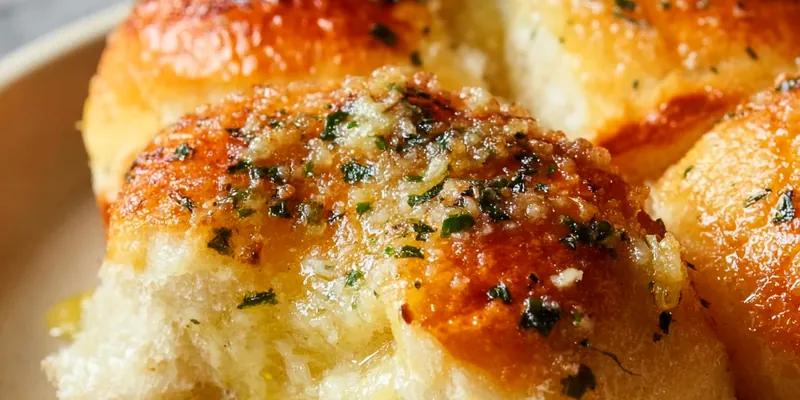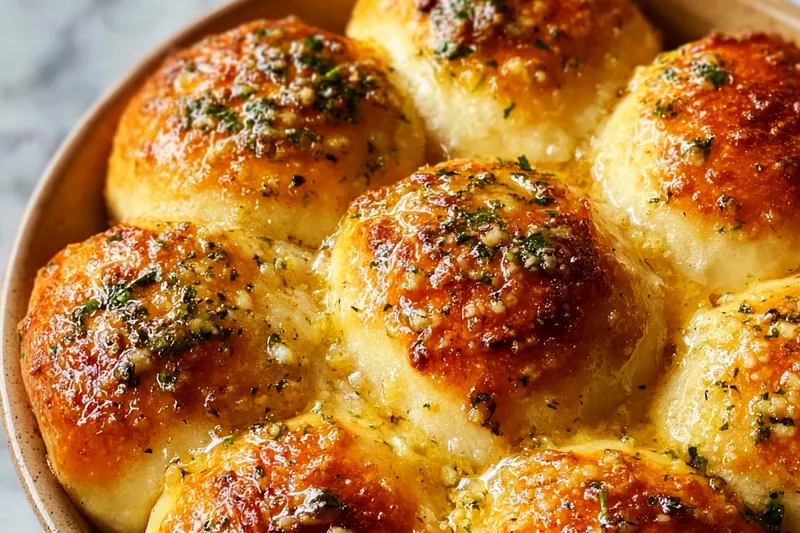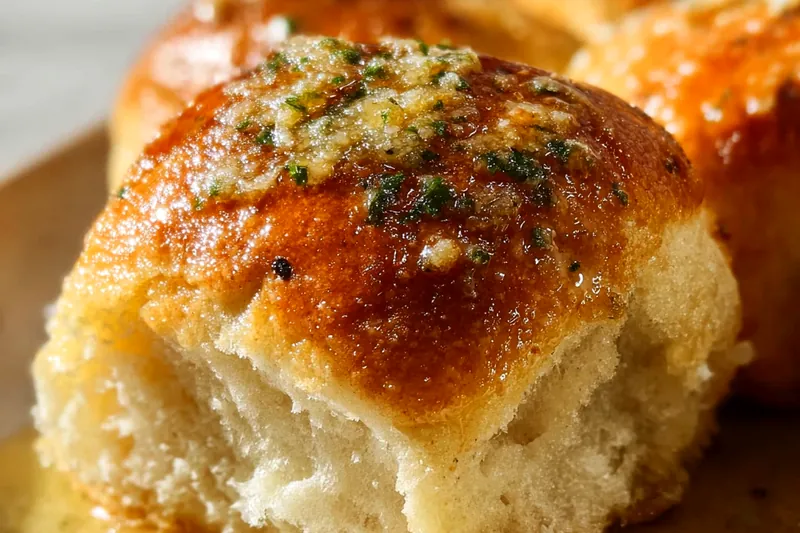Homemade Garlic Bread Rolls
Soft, buttery homemade garlic bread rolls with aromatic herbs and golden crust. Perfect as a side dish or appetizer for any meal.

The Foundation of Perfect Bread Rolls
Creating exceptional garlic bread rolls starts with understanding yeast activation and dough development. The key is achieving the right balance of moisture and structure through proper kneading and rising times. Temperature control during rising ensures optimal texture and flavor development.
The garlic butter mixture is equally important - using fresh herbs and high-quality butter creates layers of flavor that penetrate the soft bread. Timing the application of garlic butter while the rolls are still warm allows for maximum absorption and aroma.
💡 Professional Tip
Test your yeast's activity by ensuring it becomes foamy within 5-10 minutes. Dead yeast will result in dense rolls that won't rise properly. Keep ingredients at room temperature for even mixing.
Frequently Asked Questions
Yes, after the first rise, punch down the dough and refrigerate overnight. Let it come to room temperature before shaping and completing the second rise.
The rolls should nearly double in size and feel light and puffy. Gently press with your finger - if the indentation springs back slowly, they're ready to bake.
Yes, freeze baked rolls for up to 3 months. Thaw at room temperature and warm in a 300°F oven for 5-7 minutes before serving. Apply fresh garlic butter when reheating.
You can substitute with 1 tablespoon total of dried herbs, but reduce the amount as dried herbs are more concentrated. Fresh herbs provide superior flavor and aroma.
Dense rolls usually result from dead yeast, over-kneading, insufficient rising time, or too much flour. Ensure proper yeast activation and adequate rising in a warm environment.
Store in an airtight container for up to 3 days. Reheat in a 300°F oven for 5 minutes to restore softness, then brush with additional garlic butter if desired.
Yes, divide the dough into 18-24 smaller pieces for mini rolls. Reduce baking time to 12-15 minutes and watch carefully to prevent over-browning.
Serve warm as a side dish with pasta, soups, or salads. They also make excellent sandwich rolls or can be served as an appetizer with marinara sauce for dipping.
Recipe Troubleshooting Guide
Rolls Not Rising
Problem: Dough doesn't double in size during rising
Solution: Check yeast expiration date, ensure water temperature was correct (105-115°F), and place dough in a warm, draft-free environment. Cover properly to prevent drying.
Tough or Chewy Texture
Problem: Rolls turn out tough instead of soft
Solution: Avoid adding too much flour during kneading. Knead just until smooth and elastic. Over-kneading or too much flour creates tough bread.
Uneven Browning
Problem: Some rolls brown faster than others
Prevention: Ensure rolls are evenly spaced and similar in size. Rotate baking sheet halfway through cooking time. Check oven hot spots with an oven thermometer.
Garlic Butter Too Greasy
Problem: Garlic butter separates or feels too oily
Recovery: Ensure butter is properly softened, not melted. Mix thoroughly and let come to room temperature before applying to warm rolls.
Bland Flavor
Problem: Rolls lack garlic and herb flavor
Prevention: Increase fresh garlic and herbs in the butter mixture. Apply garlic butter while rolls are still warm for better absorption. Don't skip the salt in the butter.
Texture Issues
Too Sweet: Add a pinch more salt to balance sweetness
Too Salty: Reduce salt in both dough and garlic butter mixture
Bland: Increase garlic, herbs, or add lemon zest to the butter mixture

Selecting Quality Ingredients
The foundation of exceptional garlic bread rolls lies in choosing the right flour and yeast. Bread flour provides the protein content necessary for proper gluten development, resulting in rolls with the ideal texture - soft interior with enough structure to hold the garlic butter.
Fresh garlic and herbs make a significant difference in the final flavor profile. While dried herbs can substitute in a pinch, fresh parsley and chives provide brightness that complements the rich butter and enhances the overall eating experience.
Essential Ingredient Notes
- Bread Flour: Higher protein content than all-purpose flour creates better gluten structure for soft yet sturdy rolls that won't fall apart when buttered.
- Fresh Yeast: Check expiration dates and store yeast properly. Active dry yeast should foam vigorously when activated - this indicates healthy, active yeast for proper rising.
- Quality Butter: Use unsalted European-style butter for the richest flavor. The higher fat content creates a more luxurious mouthfeel and better herb integration.

Mastering the Bread-Making Process
Proper kneading technique is essential for developing the gluten structure that gives rolls their characteristic soft, pillowy texture. The dough should be smooth and elastic after kneading, with a slight tackiness that indicates proper hydration without being sticky.
Temperature control during both rising periods ensures optimal yeast activity and flavor development. The ideal rising environment is warm but not hot - around 75-80°F. Too much heat can kill the yeast, while cool temperatures slow the process significantly.
The Perfect Rise
Create an ideal rising environment by placing the covered bowl in a slightly warm oven (turned off) or near a warm stove. The dough should double in size and feel light and airy.
Homemade Garlic Bread Rolls
📋 Ingredients
For the Bread Rolls
- 120g unsalted butter, softenedBase for the aromatic garlic butter
- 6 cloves garlic, mincedFresh garlic for bold flavor
- 30ml fresh parsley, choppedAdds color and freshness
- 15ml fresh chives, choppedSubtle onion flavor
- 5g dried oreganoMediterranean herb essence
- 2g garlic powderIntensifies garlic flavor
- 30g grated Parmesan cheeseAdds umami depth
For the Garlic Herb Butter
- 500g bread flourHigh protein content for structure
- 7g active dry yeastLeavening agent for rise
- 15g granulated sugarFeeds yeast and adds slight sweetness
- 240ml warm milkCreates tender crumb
- 60ml warm waterFor yeast activation
- 60g unsalted butter, meltedEnriches dough and adds flavor
- 1 large eggProvides structure and richness
Instructions
Activate Yeast
In a small bowl, combine warm water, sugar, and yeast. Let stand for 5-10 minutes until foamy and bubbly.
Make Dough
In a large bowl, combine flour and salt. Create a well in center and add activated yeast mixture, warm milk, melted butter, and egg. Mix until a soft dough forms.
Knead Dough
Turn dough onto floured surface and knead for 8-10 minutes until smooth and elastic. Place in greased bowl, cover, and let rise for 1 hour until doubled in size.
Prepare Garlic Butter
Mix softened butter, minced garlic, parsley, chives, oregano, garlic powder, salt, and Parmesan cheese until well combined. Set aside.
Shape Rolls
Punch down dough and divide into 12 equal pieces. Roll each into a ball and place on lined baking sheets. Cover and let rise for 45 minutes until puffy.
Bake and Finish
Preheat oven to 375°F (190°C). Brush rolls with egg wash, sprinkle with coarse salt. Bake 15-18 minutes until golden. Brush warm rolls with garlic butter and serve immediately.
Recipe Notes & Tips
Storage
Fresh rolls keep in an airtight container for up to 3 days. Reheat in a 300°F oven for 5 minutes to restore softness, then brush with additional garlic butter.
Serving Suggestions
Perfect alongside pasta dishes, soups, salads, or as an appetizer with marinara sauce. These rolls also make excellent sandwich bases for sliders or paninis.
Variations
Try adding roasted garlic for milder flavor, or experiment with different herbs like rosemary or thyme. A sprinkle of everything bagel seasoning before baking adds extra flavor complexity.
